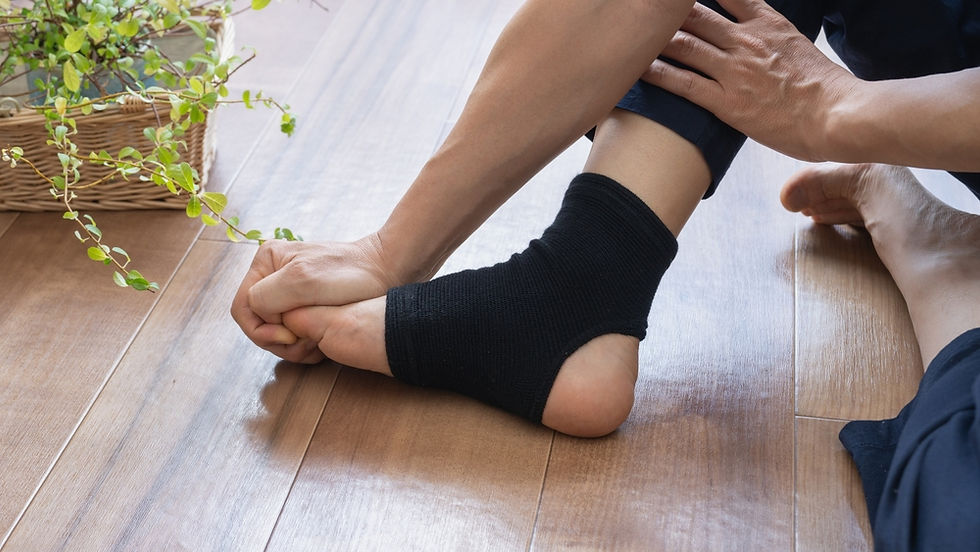Ankle Support for Sprain: Benefits and Practical Considerations
- AQF Sports
- Aug 18, 2023
- 4 min read
So, you've sprained your ankle – an all-too-common annoyance that can sideline your active lifestyle. Fortunately, the world of ankle support is here to help you on your road to recovery and prevention. In this guide, we'll explore the benefits of ankle support for sprains, whether it's suitable for walking, the advantages of orthopedic ankle braces, the differences between ankle brace support stabilizers and ankle support sleeves, techniques for wrapping a sprained ankle without a bandage, strategies to reduce swelling, the role of ankle braces in
preventing sports-related sprains, and the optimal duration for ankle wrapping. Let's dive in!

Benefits of Ankle Support for Sprain:
Ankle support following a sprain is akin to a helping hand on your healing journey. Here's why it's a good idea:
Stability and Protection:
Ankle support, whether in the form of braces, sleeves, or wraps, offers stability to your injured joint. This stability prevents excessive movement, reducing the risk of further injury and allowing the sprained ligaments to heal properly.
Reduced Swelling:
Ankle support can aid in reducing swelling by providing compression, which promotes better blood circulation and limits fluid accumulation around the injured area.
Pain Management:
Properly fitted ankle support can help alleviate pain by offering support to the injured ligaments and reducing strain during movement.
Enhanced Healing:
Ankle support helps create an optimal environment for healing by preventing unnecessary stress on the sprained ligaments, enabling a speedier and smoother recovery process.
Suggested Read: 7 Common Sports Injuries You Need to Know About!
Ankle Support for Walking: Yes or No?
Yes, ankle support is beneficial for walking after a sprain. Walking without proper support can aggravate the injury and impede healing. Ankle support provides stability, reducing the risk of further strain while allowing you to continue with light activities like walking. However, consult your healthcare provider for guidance on the type and duration of support needed for safe walking.
Benefits of Orthopedic Ankle Braces:
Orthopedic ankle braces are specialized supports designed to aid recovery and prevent future injuries. Their benefits include:
Customized Support: Orthopedic ankle braces are often adjustable, allowing for a personalized fit that caters to your specific needs.
Controlled Movement: These braces often incorporate hinges or straps that permit controlled movement, facilitating rehabilitation exercises without compromising stability.
Reinforced Protection: Orthopedic braces offer enhanced protection, making them ideal for individuals with a history of ankle issues or those engaged in high-impact activities.
Ankle Brace Support Stabilizer vs. Ankle Support Sleeve:
The choice between an ankle brace support stabilizer and an ankle support sleeve depends on your requirements:
Ankle Brace Support Stabilizer: These provide rigid support, making them suitable for acute injuries or cases requiring maximum stability during physical activities.
Ankle Support Sleeve: More flexible and lightweight, ankle support sleeves offer compression and minimal support. They're suitable for mild sprains, reducing swelling, and as preventive measures.
Wrapping a Sprained Ankle without a Bandage:
If you lack a bandage, you can use a self-adhesive elastic wrap or an ACE bandage alternative. Start from the base of the toes, wrapping upwards towards the calf. Ensure a snug, yet not too tight, fit to provide support and compression.
How to Reduce Swelling through Ankle Wrapping:
To effectively reduce swelling, follow these steps:
Elevate: Keep your sprained ankle elevated above heart level whenever possible to promote fluid drainage.
Cold Compress: Apply a cold compress wrapped in a cloth for about 15-20 minutes every hour to reduce swelling.
Compression Wrap: Use an elastic bandage to wrap your ankle, providing gentle compression to minimize swelling.
Stay Mobile: Gentle, controlled movement can help stimulate blood circulation and reduce fluid buildup.
Ankle Brace for Basketball and Sports Sprain Prevention:
Basketball and similar high-impact leg exercises put your ankles at risk for sprains. Ankle braces can be your ally in prevention by offering stability, reducing the risk of sudden movements that could lead to injury, and enhancing proprioception for better body awareness during dynamic activities.
Duration of Ankle Wrapping:
The duration of ankle wrapping depends on the severity of your sprain and your healthcare provider's recommendations. Generally, you may need to wrap your ankle for a few days to a couple of weeks. However, ensure you don't rely solely on wrapping; gradually transition to more flexible supports or exercises as your ankle heals.
FAQs
Is ankle support good for a sprained ankle?
Yes, ankle support is beneficial for a sprained ankle as it provides stability, reduces strain, and promotes proper healing.
What is best to wear for a sprained ankle?
A supportive ankle brace or wrap is best for a sprained ankle, offering stability and protection during recovery.
What support for a badly sprained ankle?
For a badly sprained ankle, consider using a rigid ankle brace or support stabilizer for maximum stability and protection.
How do you heal a sprain fast?
To heal a sprain quickly, follow the R.I.C.E. method: Rest, Ice, Compression, and Elevation. Additionally, consult a healthcare professional for proper treatment and guidance.
What worsens a sprained ankle?
Continuing strenuous activities without proper support, not allowing adequate rest, and neglecting proper rehabilitation can worsen a sprained ankle.
Conclusion
In conclusion, ankle support is your steadfast companion on the path to recovery and injury prevention. Whether you opt for braces, sleeves, wraps, or other forms of support, their benefits encompass stability, protection, reduced swelling, and enhanced healing. They empower you to continue walking after a sprain and engage in activities with confidence. Remember, the type of support and duration depend on factors like the severity of your injury and the nature of your activities. Always consult a healthcare professional to receive personalized guidance tailored to your specific situation.
.png)


Comments